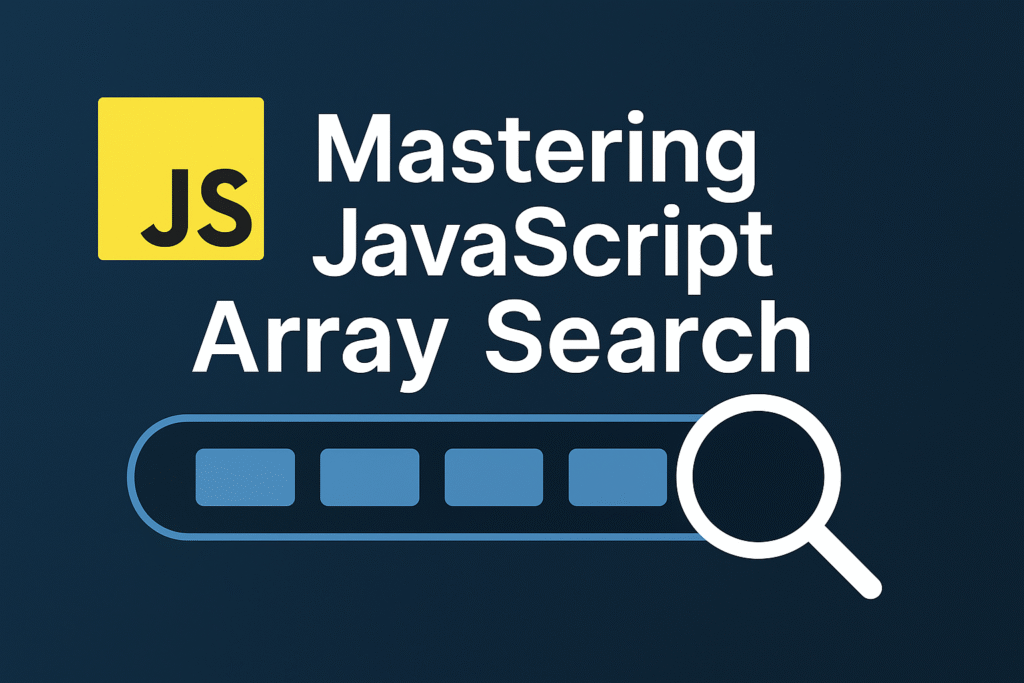Arrays are a basic tool in JavaScript, and knowing how to perform a JavaScript array search quickly is super important. This article will show you easy ways to find things in your arrays, with simple examples and tips to keep your code running smoothly.
Why is Searching Arrays Efficiently Important?
Imagine you have a big list of user info, product details, or activity logs in a JavaScript array. If you search this list slowly, it can make your web application feel sluggish, which nobody wants. Choosing the right JavaScript array search method can really speed things up and make your code more efficient.
JavaScript Array Search Methods: The Simple Version
JavaScript gives you several built-in ways to search arrays. Each one has its own strengths and weaknesses, so they’re good for different jobs. Let’s look at the most common ones:
indexOf(): Finding the First One
TheindexOf()method tells you the index (position) of the first time it finds something in the array. If it doesn’t find it at all, it returns -1.
- It compares items using strict equality (
===). - Example:
- Good For: Checking if something is in an array and where it is. Making sure you don’t add duplicates.
- Speed: It can be slow (O(n)) in the worst case, meaning it might have to check every item in the array.
lastIndexOf(): Finding the Last One
Similar toindexOf(), but it finds the *last* time the item appears in the array.
- Example:
- Good For: When you need to know the very last place an item is in an array.
includes(): Checking If It’s There
Theincludes()method simply tells you if an array contains a certain item, returningtrueorfalse.
- Example:
- Good For: Just checking if something is in an array, without needing to know where.
find(): Finding the First Match
Thefind()method lets you search for the first item in an array that matches a condition you set up. It gives you the actual item, orundefinedif it doesn’t find anything.
- Example:
- Good For: Finding an object in an array based on one of its properties, or finding the first item that meets a more complex rule.
findIndex(): Finding the Place of the First Match
Likefind(), but it gives you the *index* (position) of the first matching item, instead of the item itself. It returns -1 if there’s no match.
- Example:
- Good For: When you need the position of the first item that matches your condition.
filter(): Finding All the Matches
Thefilter()method creates a *new* array containing *all* the items that match a condition you set up.
- Example:
- Good For: Getting a list of *all* the items that match a condition. Implementing search features where you want to show multiple results.
A Note on Performance
indexOf(),lastIndexOf(),includes(),find(), andfindIndex()can be slow (O(n)) in the worst case.
filter()is also O(n) because it has to check every item. Plus, it creates a *new* array, which uses more memory. When performing a JavaScript array search in very large arrays, this performance consideration becomes more significant.
For very large arrays and frequent searches, you might want to use a different data structure, like a Map (an object with more flexible keys). A Map can make searches much faster (O(1)), but setting up the Map takes some time initially (O(n)). Check out this Stack Overflow answer and this article on DEV Community for more info.
Best Practices for Searching Arrays
- Pick the right method: Use the method that best fits what you’re trying to do.
includes()is better thanindexOf()for simple existence checks. Usefilter()to get all the matches. - Write clear code: Make your JavaScript array search logic easy to follow.
- Think about speed with big arrays: If performance is a big deal, look into other data structures or ways to optimize your code.
Conclusion
JavaScript gives you lots of ways to search arrays. By understanding how each method works and how fast it is, you can write code that’s both efficient and easy to read. Always choose the best tool for the job, and keep your code clear and understandable.


